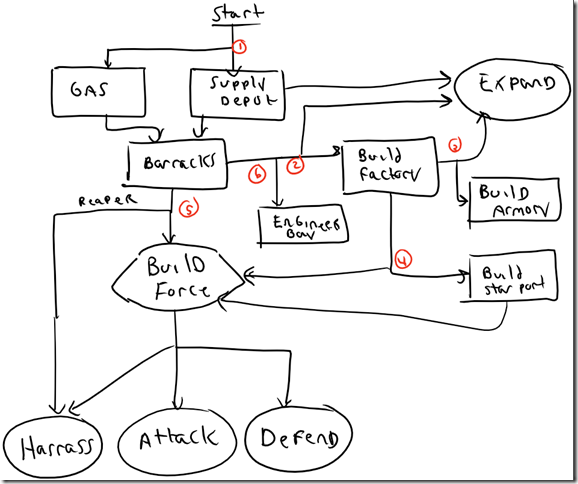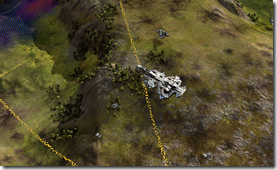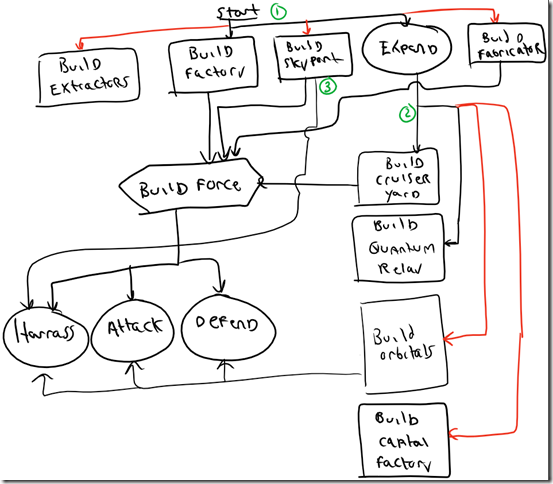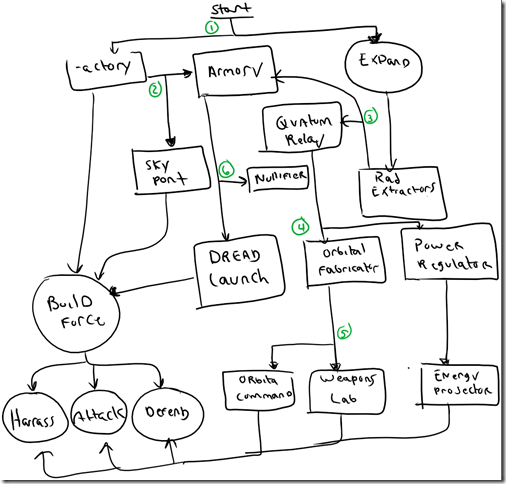
Featured Blog | This community-written post highlights the best of what the game industry has to offer. Read more like it on the Game Developer Blogs or learn how to Submit Your Own Blog Post
Ashes of the Singularity: PRE-mortem
The trials and tribulations of designing a modern RTS. Some random thoughts on how to ensure there are meaningful decisions for players without wrecking game pacing.

If you look back at classic games, you can see that the best ones presented users with a myriad of interesting choices right off the bat. These interesting choices were obvious and the pros and cons clear cut.
For Real-Time strategy games, I’m going to use the gold standard, Starcraft II as an example.
Below is an overly simple but illustrative series of choices that the Terran player has to make:

image
In this diagram, we have 6 very clear core choices the player has to make. Note the word “core” choices. Obviously there’s many more than and we all have to make the cut somewhere (Getting Stim vs. cloak, etc., the choice to build turrets, the list gets very long).
Some games create choices that are non-core and failing to do them will cause them to lose the game. We refer to those as “newbie traps”. For example, in Starcraft, you can’t build a Barracks without building a supply depot. Now, some veteran players have suggested that this requirement shouldn’t be there. That’s where the game designer has to make a tough call between a “newbie trap” and a “core choice”. The veteran who wants to harass super-duper early has to be weighed with the new player who just built a barracks and now has to wait sometime before they can do anything.
To recap: I am arbitrarily defining “core choice” as one in which either direction is perfectly valid and is non-nuanced. Hence, I don’t include researching Stim or Cloak (two very important game decisions in Starcraft) only because they get into a bit grayer discussion on key strategic decisions which deserves an entire article unto itself as opposed to one generic RTS game design (and in the comments I have no problem with someone lambasting me for making such an arbitrary distinction).
The point is: Good games give players clear, obvious choices. Weaker games either do not provide enough or provide too many weak choices (imagine if Stim were broken into a speed upgrade and a marksmanship upgrade).
Design Exercise: Pick an RTS that seemed promising but failed
Try to do the above diagram with it. How many core choices are there? Core as in, a new player picks up the game and these choices are obvious and neither path will cause them to lose the game. If the choice cripples the player then I would say it’s not a core choice.
Evolution of Ashes of the Singularity design

Ashes-Jan16-a
If you think this is an article where we toot our own horn about great game design, you’re in for a shock. There is a reason why Starcraft is the most popular RTS. It’s not by luck. It’s extremely well designed. It has also had years to refine and fix design issues.First off, Ashes of the Singularity is a massive scale RTS we are developing for release this Spring. The team making it are veteran developers who have worked on Civilization III, IV, V, Sins of a Solar Empire, Demigod, Battle for Middle Earth and countless other games over the years. It’s design is a mixture of Total Annihilation, Kohan, Sins of a Solar Empire and Company of Heroes combined with a new, 64-bit, multi-core engine to try to deliver something that hasn’t been done before.
With that out of the way, let’s take a look at Ashes:

image
The rest lines represent poison choices (newbie traps). As you can see, there are only 3 core choices – half of what are in Starcraft and a whopping 5 poison choices.
Let me walk you through them:
[1] Building extractors in your starting region right away
The economic build up in Ashes has 4 tiers:
Level 1: You own the region you get +1 per resource in that region
Level 2: You can build an extractor on each resource to get +1 from that resource
Level 3: If you build an amplifier on region generator, you get 50% more from that region.
Level 4: You can spend Quanta (the player made resource) to get another 33% more from that region.
We like this system but it has an ugly nuance if you do the math:
Example: Region has 4 metal deposits. Owning the region gives you 4 metal. If you invest time and resources with your engineer you can build an extractor on each one to get 8. If you build an amplifier on that power generator, you get to 12. If you spend quanta to overcharge it, you get to 16.
Here’s the problem: If your first decision with your engineer is to build extractors, that’s a big mistake. If your home region has 4 metal, you already are getting 4 per sec. If you spend another 3 minutes building extractors, you only get to 8. Meanwhile, your opponent who expands to a neighboring region can be up to 8 in less than a minute by capturing that region. Or they could have built a factory and be able to start capturing regions very fast with those units. Thus: Building extractors in your home region as your first move is a newbie trap.
[2] Building an orbital fabricator first
This is a bit more borderline and I’d love to hear in the comments what you think. If you build an orbital fabricator you can call down an incursion which is a fairly powerful force of units which can then quickly help you take the map. However, doing so will use up your stored quanta.
[3] Building a Skyport right away
This is a good way to harass other players but the problem is, air units can’t capture regions and provide no economic benefit. While harassment is an important part of an RTS to provide punishment, it still falls into a newbie trap area. It’s the same reason Blizzard requires a supply depot before you can build a Barracks. The desire for early game harassment isn’t as great as the desire to limit new players from hanging themselves.
[4] Building orbitals right after getting radioactives
Ashes has 3 resources: Metal (for building) Radioactives (for construction of more advanced things) and Quanta which is for researching and using orbitals. Metal and Rads you get from harvesting. But Quanta you get from a building you construct that costs Metal and Rads. The Orbitals and Techs consume quanta to use.
Thus, building an Orbital without having built a Quanta can lead to newbie traps.
[5] Building a capital ship factory early
Dreadnoughts are super powerful units. If your opponent gets one out before you, you’re in for a world of hurt. They are a late game unit. But you can build their factory early, which will cripple your economy. And then you can try to build one, which will cripple you as well.
Solutions
Of course, identifying weaknesses is easy. Solving them is hard. There is no substitute for time and play testing when it comes to game design. Many a new game designer has failed because they think they can spreadsheet their way to greatness.
My drawing below is only one solution of many solutions I’ve proposed:

image
This gets it up to 6 core decisions.
For naming purposes:
Factory: Builds scout, archer and brute units
Armory: Builds Zeus, Apollo, Nemesis and Artemis
Dread Launch: Builds Cronus, Hyperion, Prometheus
Orbital Fabricator: Can call down an Engineer or an incursion force from orbit, Unlocks Repair Bay
Power Regulator: Can permanently increase a region’s output by 33% or overcharge a generator temporarily to greatly boost its output, Unlocks Amplifier
Energy Projector: Can heal units or disable Substrate shields from orbit,
Weapons lab: Can place a turret or place a plasma storm from orbit, Unlocks Drone Defense
Orbital Command: Can bring down an orbital strike (nuke) from orbit
Orbital Nullifier: Prevents enemy orbital powers in the area it’s in.
Of course, are they really core decisions? Or are they artificial decisions that wreck game pacing? That’s where play testing comes in. Lots and lots of it.
You can keep up with Ashes of the Singularity at www.ashesofthesingularity.com. It is due out this Spring.
Read more about:
Featured BlogsAbout the Author(s)
You May Also Like







.jpeg?width=700&auto=webp&quality=80&disable=upscale)








